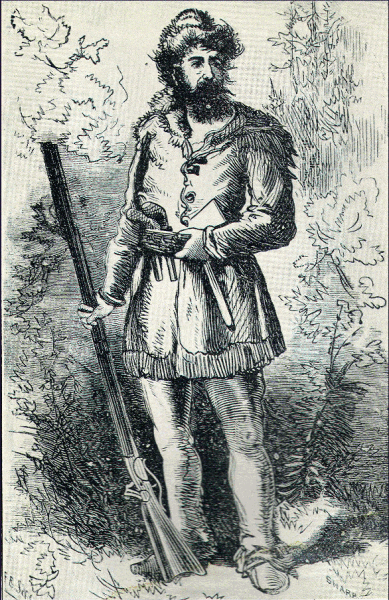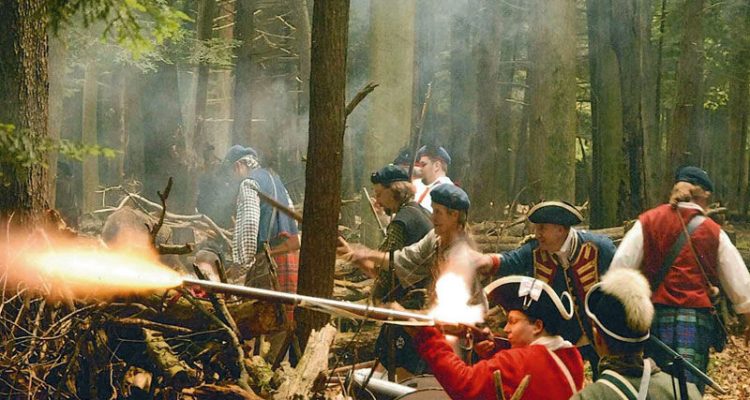Captain Samuel Brady – Hero of the Revolution
Part 1
During the Revolutionary War, the most well-known and respected individual in the Upper Ohio Valley was not named McCullough or Zane or Wetzel. The most famous hero of the day was Capt. Samuel Brady. I hope you enjoy this storyteller’s account of the life and times of Capt. Samuel Brady.

Sam Brady was born at the Brady farm near Shippensburg, Pa., on May 5, 1756. His parents were Capt. John Brady of the Pennsylvania Militia and his wife, Mary. Sam was the oldest of 12 children, two of whom died in infancy. When George Washington put out the call for troops in 1775, Capt. John Brady and his two oldest sons, Samuel and James, headed east to join the Continental Army. Sam was 19, and James was 16. The brothers entered the Army as privates, and John kept his rank of captain. They were assigned to the command of Gen. “Mad” Anthony Wayne, where they eventually became spies and scouts working out of Gen. Wayne’s headquarters.
The Bradys participated in the battles of Boston, New York, Trenton, Princeton, and Brandywine Creek. At the Battle of Brandywine Creek, they became part of some 400 or more American fighters who were taken prisoner. The British put the prisoners into a stockade with walls consisting of rows of poles sunk into the ground. The walls were some 12 feet high or so, so the British assumed that escape was impossible. Some of the prisoners noticed that the British guards were lax about checking the back side of the stockade where a Sally port consisting of a small gate bolted from the outside was located.
Sam Brady was known for his athletic abilities especially when it came to running and jumping. When the all-clear was given shortly after dark, Sam made a run for it. With a boost from James and some of the other men, Sam jumped up and grabbed the top of the stockade. He waited for the all-clear again and then quickly dropped down on the other side. The back side of the stockade faced the woods only a few feet away, so Sam hid in the bushes until the sentries were out of sight at which time he quietly unbarred the Sally gate. Before the British guards realized that anything was up, more than 50 of the Americans, including the Bradys, had escaped into the swampy woods.
The Bradys rejoined Wayne’s troops in time to participate in the Battle of Germantown. By this time, Lt. Samuel Brady was working out of Wayne’s headquarters as a spy and scout. As the real historians will recall, the Battle of Germantown did not go well for the Americans. It also did not go well for the Bradys. During the foggy battle, a musket ball struck Captain John Brady in the mouth knocking out his front teeth and leaving an exit wound in his cheek the size of a man’s thumb. The wound became infected and the infection spread to Capt. Brady’s lungs, giving him a bad case of pneumonia. Assuming that John was going to die, James, who was also wounded, was given leave to take his father back to their home in Shippensburg. When they recovered, they were to report to Fort Pitt to assist with the efforts to deal with the Indian problem in the west. Samuel Brady spent the winter of 1777-1778 with the army at Valley Forge.
Some of the Indians in Pennsylvania, Western Virginia, and the Ohio country were supporting the British war effort by waging a “terrorist-like” war against the homes of the men who were back east serving in the Continental Army. During our American History classes, we learned about the men who deserted from Washington’s army to go home to harvest crops. However, we were never told that many of the deserters went home to protect their families from the Indian raiding parties that were raping, torturing, and killing the family members who were left defenseless because the men were away in the army. The level of brutality of the raiding parties varied widely, but some of them were very brutal. One of the Indians who participated in raids on the homes of soldiers during the war recalled his experiences to an interviewer in the early 1800s. He said that the raiding parties in which he participated especially targeted farms where there were daughters for them to enjoy. In addition to raping and killing the families, those raiding parties would take anything of value before burning the buildings. By the time the raiding party headed back home, they were loaded down with livestock, clothing, cook pots, tools, and anything else that could be used or sold. There were traders who were more than willing to buy any of the plunder that the Indians wanted to sell.
Chief Bald Eagle was responsible for many of the Indian raids in central and southern Pennsylvania. James Brady was very well known for his long red hair. Shortly after James arrived home in late October 1777, Bald Eagle heard about his long red hair and declared that he was going to have that scalp.
Before continuing the story, it is worthwhile to note that some internet sites depict Capt. Samuel Brady with red hair. Sam Brady did not have red hair. His hair was jet black. Sam was six feet tall with jet black hair and blue eyes. His skin was somewhat fair but tanned as dark as an Indian because of all the time he spent outdoors. He had a thin, lanky, muscular build and was known for his athletic ability.
On Aug. 8, 1778, Bald Eagle and his men surprised James Brady while he was helping one of his neighbors hoe corn. The other two men in the field were able to escape, but all of the Indians converged on James. He was struck on the head with the flat side of a tomahawk. Then Bald Eagle scalped him and left him for dead. James later regained consciousness and stumbled to the cabin of a neighboring farmer where he lingered for several days before dying.
Capt. John Brady recovered from his wounds and rejoined the Army in Pennsylvania. However, he was killed in an Indian Ambush on April 11, 1779.
Shortly after his father’s death, Lt. Sam Brady and two companions were sent home to central Pennsylvania. After visiting his mother, Sam had orders to report to Gen. Broadhead at Fort Pitt to assist with the effort to deal with the Indian problems in the west. On the way to Fort Pitt, Sam and his companions learned that an Indian raiding party had recently attacked the home of a soldier named Frederick Henry about 40 miles southeast of Fort Pitt. The Indians raped and killed Mrs. Henry and had killed four of their seven children. After burning the Henry home, they took 14- year-old Peter Henry, 12-year-old Elizabeth Henry and their 5-year-old baby sister captive.
Sam and his companions followed the trail of the raiding party. After several miles, they discovered the body of the 5-year-old girl thrown into a thicket. She would not stop crying for her mother, so Bald Eagle killed her with a tomahawk blow to the head to keep her cries from giving up their location. Then, he picked her up by an ankle and tossed her body into the weeds as one might toss a fallen limb off the trail.
After tracking the raiding party for two weeks, Brady and his companions came upon the Indians as they were preparing to make camp along the Allegheny River in a place northeast of Pittsburgh that is now known as Brady’s Bend. The Allegheny makes a hairpin turn in that location. The party consisted of seven Indians including Chief Bald Eagle. The Indians had a goodly number of animals laden with packs containing all of the plunder from their raids. The two Henry children were each tied to an Indian by a rope tied around their neck.
The three men watched silently as the Indians made camp and settled down for the evening. Late into the night, the three men slipped silently into the encampment. Each man had a cocked and loaded rifle in one hand and a tomahawk in the other. At the signal, three Indians were killed by rifle shots, and three others were killed by tomahawk blows as they arose. One of the Indians killed by Brady was Chief Bald Eagle. The seventh Indian escaped by running into the woods.
After being untied, Peter Henry picked up a tomahawk, hacked off the head of Chief Bald Eagle, and threw it into the fire announcing, “He killed my mother and sister.” The long, red-haired scalp on Bald Eagle’s belt also went into the fire. The next morning, the party made its way toward Fort Pitt.
As soon as they reached the fort with the load of animals and plunder from the Indians, General Broadhead sent for Brady. Broadhead notified Brady that he was immediately promoted to captain. Broadhead commissioned Brady to raise an independent detachment of rangers of his choosing. Their orders were simple. They were to pursue the Indian raiding parties and kill them thereby putting an end to the terror in the west. Brady was to headquarter the rangers at Fort McIntosh located about 25 miles north of Fort Pitt at the junction of the Beaver and Ohio rivers. Brady liked the idea of being stationed at Fort McIntosh because his good friend Van Swearingon lived in Wellsburg, which was only a one-day ride away. Van’s brother, Andrew Swearingon, commanded Holliday’s Fort (Weirton), which was on the way to Wellsburg.
During one of his visits to the Swearingon home in Wellsburg, Sam met Van’s daughter, Drucilla, who had returned from being educated back east. Drucilla, called Dru by her father, was immediately attracted to Sam, and it was very clear that he was equally impressed with her. As a result, Sam’s visits to Wellsburg became more frequent. Drucilla wanted to marry Sam, but her father was not in favor of the marriage because he was sure that Sam would be killed by the Indians leaving his daughter widowed. In spite of Van’s objections, Sam brought an extra horse with him on one of his trips to visit, and the couple quietly slipped out of town. They went to West Liberty, where Ben Biggs had made sure that a young Presbyterian circuit rider by the name of the Rev. James (Smiley) Hughes was waiting for the couple. After spending their honeymoon night in a room at Biggs’s Ordinary, the couple returned to Welllsburg where Van did what any loving father would do in that situation. He threw the biggest wedding celebration that the town had ever seen! Sam and Dru were married in 1785. It is worth noting that Van Swearingon also had a land grant and a home near Catfish Camp, which is now known as Washington, Pa. His home in Wellsburg was on a 300-acre tract of land that he had purchased from one of the Cox brothers.
Here is a side note: the Rev. Smiley Hughes (AKA Reverend James Hughes) was a Presbyterian minister who served the churches in the Short Creek, Buffalo Creek, and West Liberty area in the late 1700s and early 1800s. The Presbyterian Church in West Liberty was formed in 1788; Smiley Hughes was formally installed as its first pastor on April 21, 1790. Smiley Hughes is buried in the old West Liberty Cemetery. A couple of accounts of Sam Brady’s life describe Sam as a devout Presbyterian and a student of the Bible!




